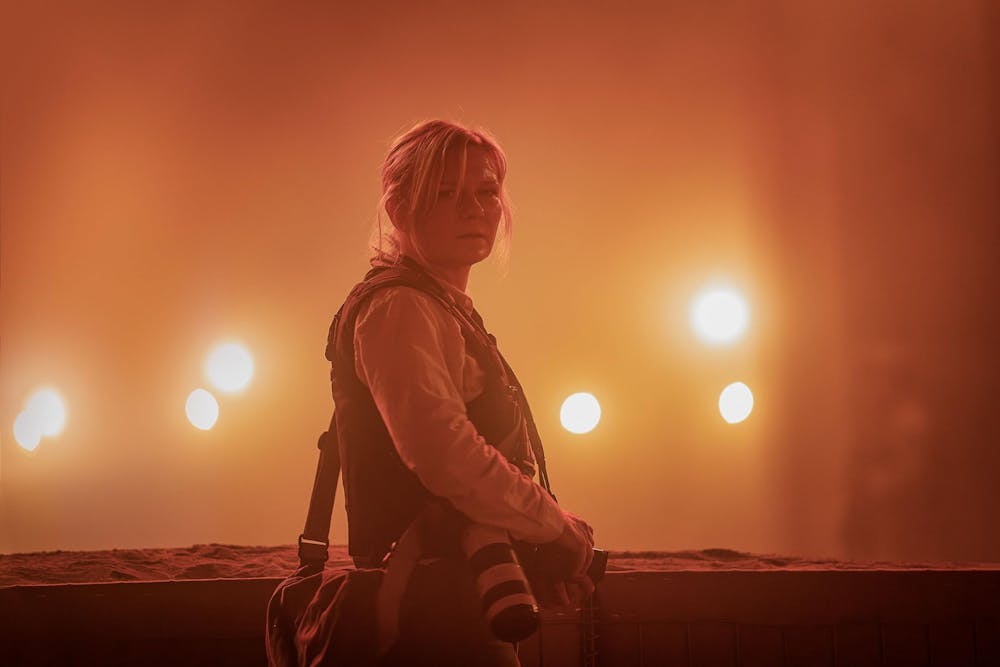After director Alex Garland’s last directorial effort in the horror flick “Men” left audiences divided (and mostly disappointed), it seemed like a strange choice for A24 to hand him their largest budget yet ($50 million) to make “Civil War.”
Its budget doesn’t necessarily feel wasteful or unjustified, but “Civil War” is still far from Garland or A24’s best work.
Garland began his film career in 2002 when he wrote the iconic apocalyptic horror film: “28 Days Later.” Since then, Garland has transitioned from writing to directing, releasing his directorial debut “Ex Machina” in 2014, a sci-fi thriller that remains his most critically acclaimed film. Before the alienating release of “Men” in 2022, Garland made the science fiction horror film “Annihilation” – his only endeavor without A24.
Throughout his career, Garland’s apocalyptic, dystopian and futuristic roots from “28 Days Later” remain prevalent – and “Civil War” is no different.
Set in a not-so-distant future, “Civil War” envisions a second American Civil War that begins with California and Texas seceding from the U.S. Garland neglects to explain why this war began, but we know that California and Texas are now united as the “Western Forces” and are nearing victory over the United States’ government forces.
Rather than following the conflict at hand or getting into the nitty-gritty whats, whys and hows of the war, “Civil War” follows four journalists as they attempt to travel from New York City to Washington D.C.
Their goal is to interview and photograph the president (Nick Offerman), who – once again – we know little about, except that he is currently serving his third term.
Kirsten Dunst delivers an afflicted performance as Lee Smith, a war-torn photographer and the film’s protagonist. The rest of this ragtag, capital-bound foursome is made up of the sweet-talking journalist Joel (Wagner Moura), the 23-year-old aspiring photographer Jessie (Cailee Spaeny) and the older, sage-like character Sammy (Stephen McKinley Henderson).
As “Civil War” follows the group across their 857-mile-long winding journey, it paints a picture of this apocalyptic America, coming across abandoned towns, refugee camps and armed militia groups.
It feels as if “Apocalypse Now” and “The Last of Us” had a baby born in the middle of post-Jan. 6, 2021 Capitol riot America.
On paper, “Civil War” has all the makings of a very striking political-charged war film. The decision to make this film through a journalistic lens is compelling and refreshing. It allows audiences to see all sides of this conflict and brings objectivity to the film, which is furthered by the film’s lack of real politics.
Beyond the film’s angle, Dunst delivers an Academy Award-worthy performance in “Civil War.” The sound design for the battle scenes can be truly incredible, even if a little tiresome and cheap (we get it, loud noises are startling).
But, overall, it doesn’t work. The film has redeeming qualities, but “Civil War” is completely lacking anything real.
Its absence of politics, which has been a popular critique and compliment given to the film, was a real annoyance when watching. Garland is so close to delivering a sucker punch to American politics — he’s looking at news and the media while also posing the American government as a fascist entity.
All of this should make for a damning critique of America coming off of the back of Trump’s presidency. But apart from a vague condemnation of fascism – which is a boiling hot and never-before-seen take – nothing else comes to fruition.
Garland shies away from saying anything real or substantive and instead delivers a strange road movie that seems to be set in a zombie or virus-led apocalypse rather than a nation distraught by a civil war.
There are also multiple moments throughout “Civil War” that completely remove you from the viewing experience. From lazy jokes that would feel much more at home in a Marvel movie to the laughable inclusion of “Say No Go” by De La Soul right after an intense battle sequence, tonally, “Civil War” is a complete mess.
When “Civil War” isn’t confusing the audience on what kind of film it is, there is some pretty grueling and disturbing imagery.
In an interview with Letterboxd, Garland said he asked the cast to watch Elem Klimov’s 1985 film “Come and See,” a film famous for being one of the most harrowing yet effective anti-war movies.
Parallels between the two films can definitely be made. “Civil War” follows a similar trajectory as “Come and See,” both following their characters from one traumatic event to another and hitting similar dramatic beats.
However, to know that Garland was aiming for a comparable effect to “Come and See” feels inappropriate and disrespectful.
Where “Come and See” is charged with nothing but trauma, “Civil War” fills the spaces between its harshest scenes with inane and disorganized scenes of nothingness or a strange sense of contentedness.
Both films are aiming to critique fascism and war in their own ways, but “Civil War” has moments of desperation that feel out of place with the rest of the film. Garland attempts to craft both a political film and a harrowing anti-war film, but he never gives either one the attention they deserve and instead ends up with a confusing and potholed story.
I would’ve hoped for more from A24’s first film with a budget like this and a film diving into the prospect of a second American Civil War, but Garland’s work just doesn’t live up to its potential.
This article was edited by Bailey Hobbs, Sara Winick and Abigail Turner. Copy editing done by Luna Jinks and Charlie Mennuti.





